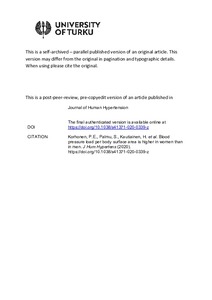Blood pressure load per body surface area is higher in women than in men
Kautiainen Hannu; Korhonen Päivi E; Eriksson Johan G; Palmu Samuel
https://urn.fi/URN:NBN:fi-fe2021042822854
Tiivistelmä
Many unexplained sex differences have been observed in blood pressure (BP) related morbidity. However, there has been little research about the most obvious difference between men and women-body size. Given that blood vessels are organs of tubular shape, we hypothesized that correction of BP for body surface area (BSA), a two-dimensional measurement of body size, would allow comparison of BP load between men and women. We assessed the relationship of 24-h ambulatory BP measurements and BSA in 534 participants (mean age 61 +/- 3 years, 51% women) from the Helsinki Birth Cohort Study. The study subjects had no previous medication affecting vasculature or BP. When BP values were adjusted for age, smoking, physical activity, and body fat percentage, males had higher ambulatory daytime mean systolic BP (131 mmHg vs. 127 mmHg, p < 0.001), diastolic BP (83 mmHg vs. 78 mmHg, p < 0.001), and mean arterial pressure (100 mmHg vs. 96 mmHg, p < 0.001) than females. However, all BP components per unit of BSA were significantly lower in males: daytime mean systolic BP (65 mmHg vs. 71 mmHg, p < 0.001), diastolic BP (41 mmHg vs. 44 mmHg, p < 0.001), pulse pressure (24 mmHg vs. 28 mmHg, p = 0.013), and mean arterial pressure (49 mmHg vs. 54 mmHg, p < 0.001). The same phenomenon was observed in night-time BP values. BP load per BSA is higher in women than in men, which may explain many reported sex differences in cardiovascular morbidity. Relatively small-sized individuals might benefit from a more aggressive therapeutic strategy.
Kokoelmat
- Rinnakkaistallenteet [19207]
